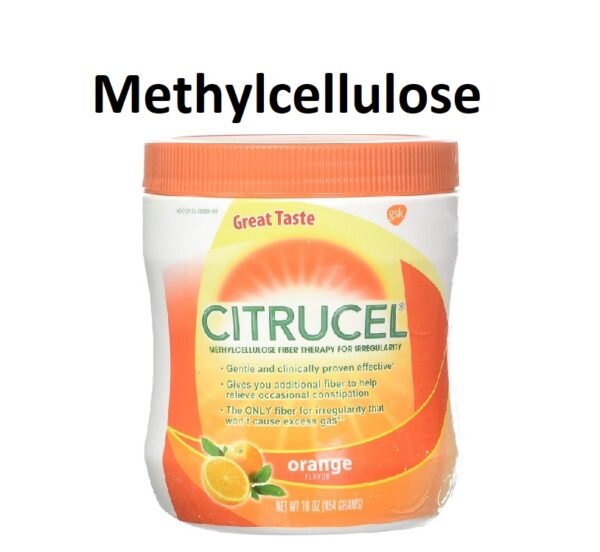Methylcellulose (Citrucel) is a bulk-forming laxative. It increases the bulk of stools resulting in improved intestinal motility and regularizing bowel movements.
Methylcellulose (Citrucel) Uses:
-
Constipation:
- It is used as an adjunct to diet and other therapies in the treatment of constipation and to restore and maintain bowel regularity.
Methylcellulose (Citrucel) Dose in Adults:
Methylcellulose (Citrucel) Dose in the treatment of Constipation: Oral:
- Citrucel tablet:
-
As much as six times a day, two caplets as needed.
-
Twelve caplets are the maximum daily dose.
-
- Citrucel powder:
- In 8 oz (240 mL) of cold water, dissolve 2 grams, or one heaping tablespoon.
- Up to three times per day, the dose may be raised by one heaping tablespoon as needed.
- Citrucel powder (sugar-free):
- 1 rounded tablespoon of 2 grams in 8 ounces (240 mL) of cold water
- If necessary, the dosage may be raised by one rounded tablespoon up to three times each day.
Methylcellulose (Citrucel) Dose in Children:
Methylcellulose (Citrucel) Dose in the treatment of Constipation: Oral:
-
Children 6 to 11 years:
- Citrucel tablet:
- One caplet as required up to six times per day;
- The maximum dose per day is 6 caplets.
- Citrucel powder:
- 2.5 level teaspoons of 1 gm in 8 oz (240 mL) of cold water
- If necessary, up to three times per day, increase the dosage by 2.5 level tablespoons.
- Citrucel powder (sugar-free):
- 1 g equivalent to 2 level teaspoons in 8 oz (240 mL) of cold water;
- increase the dose as needed by 2 level teaspoons up to thrice daily.
- Citrucel tablet:
-
Children ≥12 years of age and Adolescents:
- Refer to adult dosing.
Pregnancy Risk Category: N (Not assigned)
- It is considered safe for the treatment of constipation in pregnancy when administered with an adequate amount of fluid.
Dose in Kidney Disease:
The manufacturer has not provided any adjustments in the dose in patients with kidney disease.
Dose in Liver disease:
The manufacturer has not provided any adjustment in the dose in patients with liver disease.
Side effects of Methylcellulose (Citrucel):
- hypersensitivity reactions manifesting as a skin rash, urticaria, itching, and wheezing.
- Excessive bowel gas and flatulence
- Stool impaction (If bowel movements do not occur after three days of the drug intake, consult a healthcare provider).
Methylcellulose (Citrucel) Contraindications and warnings:
- Hypersensitivity reactions (avoid in patients allergic to the drug)
- Stool impaction and bowel obstruction
- Acute abdomen (acute appendicitis or acute/ subacute intestinal obstruction)
- Gastrointestinal ulcerations and adhesions
- Rectal bleeding or another gastrointestinal active bleed
- Difficulty swallowing.
Methylcellulose: Drug Interactions
Note: Drug Interaction Categories:
- Risk Factor C: Monitor When Using Combination
- Risk Factor D: Consider Treatment Modification
- Risk Factor X: Avoid Concomitant Use
Risk Factor C (Monitor therapy) |
|
| Dichlorphenamide | Laxatives may enhance the hypokalemic effect of Dichlorphenamide. |
Monitoring Parameters:
Monitor improvement or worsening of the gastrointestinal symptoms. Bowel obstruction may occur if not taken with an adequate amount of fluid.
How to administer Methylcellulose (Citrucel)?
- It is administered orally.
- Each dose is taken with at least 240 ml (8 ounces) of water or other liquid to prevent choking.
Mechanism of action of Methylcellulose (Citrucel):
- Methylcellulose absorbs water from the gastrointestinal tract, making the stool softer.
- It makes the stool bulkier, which improves transit through the GI tract. This also regulates bowel movements.
International Brand Names of Methylcellulose:
- Soluble Fiber Therapy
- Muciplasma
- Oftan MC
- Tear cell
- Bulk
- Davilose
- Lacril
- Lacrisyn
- Celevac
- Citrucel
- Cologel
- Citrucel
- GoodSense Fiber
- Dacryolarmes
- Methylcellulose-Bournonville
Methylcellulose Brand Names in Pakistan:
Vechlor - Vega Pharmaceuticles limited







